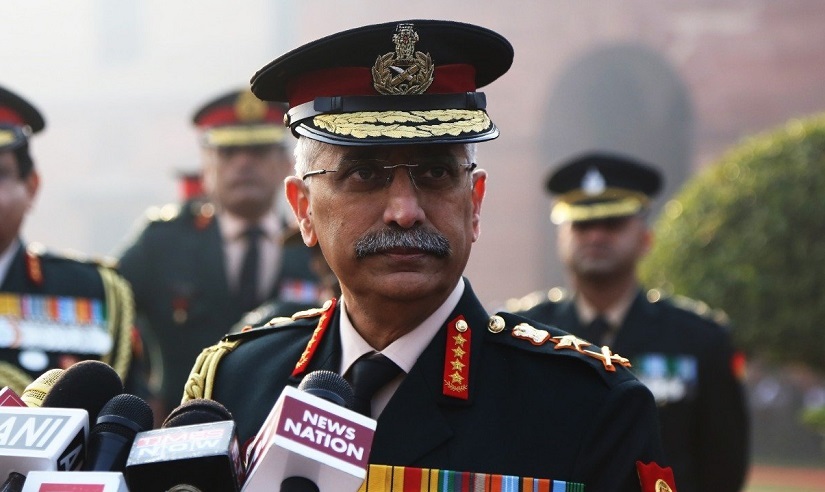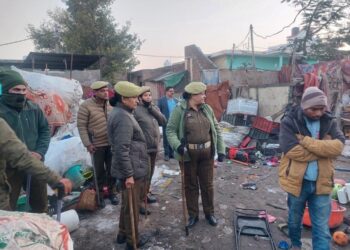
New Delhi- Chief of Army Staff Gen MM Naravane on Saturday did not rule out the possibility of Afghan-origin foreign militants attempting to infiltrate into Jammu and Kashmir once the situation stabilises in Afghanistan as he cited similar instances when the Taliban was in power in Kabul over two decades ago.
At the same time, he said Indian armed forces are prepared to deal with any eventuality as they have a very strong counter-infiltration grid as well as a mechanism to check militant activities in the hinterland in Jammu and Kashmir.
Asked at the India Today conclave whether there was any link between the spate of recent killings of civilians in Kashmir and the Taliban’s capture of power in Afghanistan, Gen Naravane said it cannot be said whether there was a connection.
“Definitely, there has been a spurt in activities (in Jammu and Kashmir) but whether they can be directly linked to what is happening in or happened in Afghanistan, we really cannot say,” the Army Chief said.
“But what we can say and learn from the past is that when the previous Taliban regime was in power, that time definitely we had foreign terrorists of Afghan origin in Jammu and Kashmir,” he said.
“So there are reasons to believe that the same thing might happen once again that once the situation in Afghanistan stabilises, then we could see an inflow of these fighters from Afghanistan to Jammu and Kashmir,” he added.
The Chief of Army Staff said the Indian armed forces are fully ready to deal with any such attempts.
“We are prepared for any such eventuality. We have a very strong counter-infiltration grid to stop them at the border. We have a very strong counter-terrorism grid in the hinterland to take care of any such actions. Just as we dealt with them in the early 2000s, we will deal with them now also should they venture anywhere near us,” he said.
On the targeted killings in Jammu and Kashmir, the Army Chief said this is a matter of “concern” and described it as “reprehensible”.
“They do not want normalcy. It is a last-ditch attempt to stay relevant,” he said, referring to militant groups.
“The people will revolt. If they (militants) say that they are doing all these for the people, then why are you killing your own people who are your support base. It is just an attempt to spread terror which is totally unacceptable,” Gen Naravane said.
About the ceasefire agreement between India and Pakistan, Gen Naravane said it was observed in “totality” for four months from February.
“But from the end of July onwards to September and now the beginning of October, the sporadic incidents have again started. I think again, it is following the pattern of 2003 when it would start with one odd incident and rise to as good as not having a ceasefire,” he said.
“Over the last month or so, we are again seeing renewed attempts at infiltration. We have eliminated two or three such infiltration attempts,” he added.
In a sudden and significant move aimed at reducing tensions, the Indian and Pakistani armies on February 25 announced that they would cease firing across the LoC while recommitting themselves to a 2003 ceasefire agreement.
“Apart from the infiltration bids, there have been three incidents of proper ceasefire violations that is one post firing at the other post,” he said.
China’s Continuous Build-Up Matter Of Concern’
The military build-up by China in the eastern Ladakh region and new infrastructure development to sustain the large-scale deployment are matters of concern and India has been keeping a close watch on all the activities by the Chinese PLA, Chief of Army Staff Gen MM Naravane said on Saturday.
He said if the Chinese military maintains the deployment through the second winter, it may lead to an LoC-like situation (Line of Control) though not an active LoC as is there on the western front with Pakistan
The Chief of Army Staff said if the Chinese military continues with its deployment, the Indian Army too will maintain its presence on its side which is “as good as what the PLA (People’s Liberation Army) has done”.
Indian and Chinese militaries have been on a standoff in several areas along the Line of Actual Control (LAC) in eastern Ladakh for nearly 17 months though both sides disengaged from a number of friction points this year following a series of talks.
“Yes, it is a matter of concern that the large-scale build-up has occurred and continues to be in place, and to sustain that kind of a build-up, there has been an equal amount of infrastructure development on the Chinese side,” Gen Naravane said at the Indian Today conclave.
“So, it means that they (PLA) are there to stay. We are keeping a close watch on all these developments, but if they are there to stay, we are there to stay too,” he said.
Gen Naravane said the build-up and the infrastructure development on the Indian side are as good as what PLA has done.
“But what this would, especially if they continue to stay there through the second winter, definitely mean that we will be in a kind of LC (Line of Control) situation though not an active LC as is there on the western front,” he said.
“But definitely, we will have to keep a close eye on all the troop build-up and deployments to see that they do not get into any misadventure once again,” the Army Chief said.
To a question, Gen Naravane said it is difficult to understand why China triggered the standoff when the world was reeling under the COVID-19 pandemic and when that country had certain issues on its eastern seaboard.
“While all that is going on, to sort of open up one more front is very difficult to understand or fathom,” he said.
“But whatever it might have been, I do not think they have been able to achieve any of those because of the rapid response done by the Indian armed forces,” the Army Chief added.
Asked to comment on the overall situation in eastern Ladakh, Gen Naravane referred to a recent statement by a spokesperson in the Ministry of External Affairs and said he had clearly mentioned that whatever has happened on the Northern border is because of the massive build-up by the Chinese side and the non-adherence to various protocols.
“So that is very clear as to what was the trigger for all that which has happened,” Gen Naravane said.
The Army Chief said following the standoff in eastern Ladakh, the Indian Army realised that it needed to do more in the area of ISR (intelligence, surveillance and reconnaissance).
“So that has been the thrust of our modernisation over the last one year. Similarly, other weapons and equipment that we thought we need for the future, those have got our attention also,” he said.
The border standoff between the Indian and the Chinese militaries erupted on May 5 last year in eastern Ladakh following a violent clash in the Pangong lake area.
Both sides gradually enhanced their deployment by rushing in tens of thousands of soldiers as well as heavy weaponry.
As a result of a series of military and diplomatic talks, the two sides completed the disengagement process in the Gogra area in August.
In February, the two sides completed the withdrawal of troops and weapons from the north and south banks of the Pangong lake in line with an agreement on disengagement.
Each side currently has around 50,000 to 60,000 troops along the LAC in the sensitive sector.
Follow this link to join our WhatsApp group: Join Now
Be Part of Quality Journalism |
Quality journalism takes a lot of time, money and hard work to produce and despite all the hardships we still do it. Our reporters and editors are working overtime in Kashmir and beyond to cover what you care about, break big stories, and expose injustices that can change lives. Today more people are reading Kashmir Observer than ever, but only a handful are paying while advertising revenues are falling fast. |
| ACT NOW |
| MONTHLY | Rs 100 | |
| YEARLY | Rs 1000 | |
| LIFETIME | Rs 10000 | |










